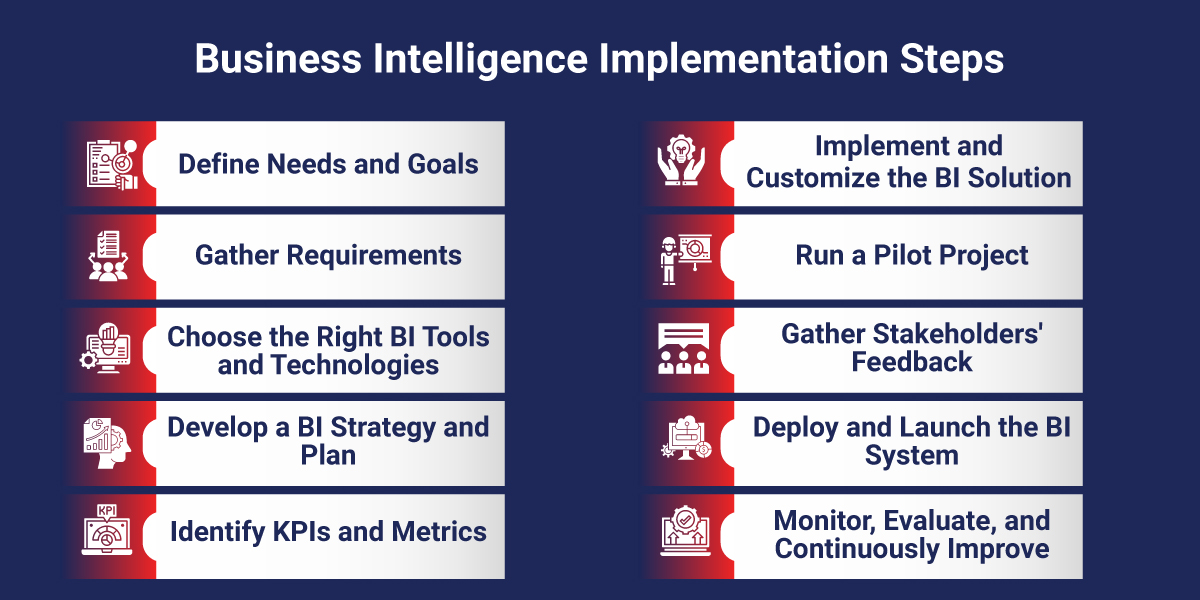Business intelligence implementation allows organizations to leverage their data assets effectively. It is key to transforming scattered business data to support strategic, tactical, and operational decision-making. Traditionally, decision-makers in large organizations often relied on their experience to make crucial business decisions. However, today, the successful implementation of BI helps organizations collect and process business data to leverage data the right way and maximize the efficiency of data assets.
The global business intelligence market is projected to grow from $8.0 billion in 2025 to $22.8 billion by 2032, highlighting the significant growth and adoption expected in the coming years.
In this blog post, we will discuss how to implement business intelligence, its challenges and solutions to help you improve overall business operational efficiency and drive more revenue.
Business Intelligence Implementation Steps
BI implementation is a multi-stage process that requires thorough preparation to ensure a comprehensive understanding of processes and results across departments and C-suite executives. The following key steps ensure a smooth and successful BI implementation, from assessing your business requirements to deploying and maintaining your BI solution.

1) Define Needs and Goals
Business intelligence implementation starts with clearly understanding the organization’s overarching business objectives, goals, risks, and expectations and how implementing BI can contribute to achieving them. The first step towards implementation is to assess your current data infrastructure, including:
- Data sources
- Reporting practices
- Existing data silos or limitations.
Work closely with department heads and stakeholders to clearly define what you want to achieve with BI and where you would use BI insights. This could involve improving operational efficiency, gaining customer insights, or boosting sales. You can identify your specific BI needs through various techniques such as interviews, workshops, questionnaires, and other methods.
2) Gather Requirements
The next BI implementation steps involve defining functional and non-functional requirements for the BI solution from all the stakeholders. The requirements can be further classified into mandatory and optional features. BI consultants play a critical role in this stage by interviewing stakeholders to collect and prioritize their needs, goals, and vision for a successful BI project implementation.
3) Choose the Right BI Tools and Technologies
Now that you have a precise understanding of your BI needs, the next step requires you to evaluate various BI tools and technologies based on factors such as:
- Scalability – Ensure the tools can accommodate your current data volume and anticipated future growth.
- Functionality – Prioritize tools that offer features relevant to your organization’s specific needs (e.g., data visualization, reporting, predictive analytics).
- Integration – Choose a tool that seamlessly integrates with your existing systems and data sources.
- User-friendliness – Choose tools with an intuitive interface for users with varying technical skills.
Identify necessary components to build a scalable BI ecosystem, including hardware resources, data storage solutions, and analytical tools to cater to your organization’s evolving requirements.
4) Develop a BI Strategy and Plan
Before diving into the technical aspects, ensuring that your business intelligence implementation strategy aligns with your organization’s overall business objectives, priorities, and strategic direction is essential. It is equally important to convince stakeholders of the value proposition of implementing BI with a robust strategy plan. Without a clear plan, employees may use inaccurate data, get conflicting instructions, and make assumptions about what things mean.
You must, therefore, create a detailed roadmap to achieve exceptional outcomes, including timelines, milestones, resource allocation, and other processes. While making the strategy, answer these three questions in detail,
- What is our current situation?
- What is our objective?
- What resources do we require?
The business intelligence implementation plan is a blueprint that provides guidelines on what would be needed to attain the goal, including scope, time frame, cost, and resources, among others. Project planning involves defining the work scope, identifying the project stakeholders, and establishing clear communication channels for efficient collaboration.
5) Identify KPIs and Metrics
Identify key measurable performance indicators to track the efficiency and status of workflows. Monitoring popular KPIs such as user adoption rate, Data quality score, and report usage metrics helps your organization track progress toward its goals and objectives. It also serves as a foundation for data-driven decision-making.
6) Implement and Customize the BI Solution
The step involves developing and tailoring the BI solution. It includes selecting the appropriate BI tools and configuring platforms for the organization’s specific data sources and infrastructure. This includes data preparation, setting up data storage, data integration, data management, customizing the BI platform, creating UI and dashboards for different departments, and performing quality assurance and optimization. The stage also involves integrating the BI solution into existing systems by automating the process with the help of data integration tools and establishing methods for extracting, transforming, and loading (ETL) data from various sources into the BI solutions.
7) Run a Pilot Project
Before deploying the BI system company-wide, testing it on a small scale, such as for one department or focus group, is recommended. This helps identify and mitigate risks, refine the implementation strategy, and help demonstrate the feasibility, functionality, and potential benefits of the BI solution once implemented organization-wide.
8) Gather Stakeholders’ Feedback
You should initiate regular meetings or discussions with BI stakeholders to evaluate the current progress of the project and propose timely changes according to the suggestions. You can also launch a trial version to collect collective feedback from the end users and convert bottlenecks into opportunities for a successful BI strategy.
9) Deploy and Launch the BI System
The final step is to launch and deploy the BI system company-wide. This involves deploying the BI solution in several iterations, monitoring performance, and troubleshooting any issues that arise. The BI solution should be scalable to meet the organization’s growth needs.
10) Monitor, Evaluate, and Continuously Improve
Business intelligence implementation is an ongoing journey, not a one-time event. Your organization must be prepared to adapt and optimize your BI solution based on the following:
- Evolving business needs: BI implementation must aim to provide actionable insight to meet your growing business needs. As your business evolves, update your BI system to ensure it delivers the correct information and supports the organization’s strategic goals and data requirements.
- Technological advancements: Stay up-to-date on emerging BI technologies and incorporate innovations; organizations can adopt innovative technologies to enhance the system’s capabilities. This may include integrating ML algorithms for predictive analytics or leveraging cloud-based platforms for scalability and flexibility.
- User feedback: Continuously refine the system to meet changing user needs and preferences based on user input and feedback to ensure maximum value. This allows an organization to ensure that it remains user-friendly.
Common BI Implementation Challenges and Their Solutions
There is no one-size-fits-all approach to implementing BI solutions that guarantees success. Organizations often face various challenges during this process, depending on factors like data complexity, existing data infrastructure, organization size, and others. Let’s explore some common challenges encountered during business intelligence implementation and ways to overcome them:
Data Quality and Integration Issues
Organizations deal with inconsistent, incomplete, or inaccurate data from multiple sources, restricting the effectiveness of BI solutions.
Solution:
Overcome this challenge by implementing the following:
- Robust data governance policies
- Data cleansing processes
- Master data management strategies
Set up a centralized data warehouse using Microsoft SQL Server Analysis Services, Oracle Exadata, or a data lake like Amazon S3 Data Lake or Azure Data Lake Storage that ensures data quality, enables practical data analysis, and helps maintain consistency across the organization.
User Adoption and Change Management
Employee adoption is essential for BI success. Therefore, a lack of user adoption can undermine the success of a BI implementation. Addressing this challenge requires effective change management strategies and comprehensive user training that can communicate the benefits of the BI system.
Solution:
Involve end-users early in the process and provide them with comprehensive training programs. Explain the tangible benefits of BI implementation and how it will improve the overall business operations. Ensure user-friendly interfaces and intuitive reporting tools.
Performance and Scalability
As businesses evolve, data volumes grow, and user demands increase. BI solutions must be scalable to handle the growing data loads without facing performance bottlenecks and scalability issues.
Solution:
Businesses should implement a robust hardware infrastructure, optimize data models, and consider cloud-based or distributed architectures that provide seamless scalability and performance.
Security and Data Privacy
Safeguarding sensitive enterprise data from breaches while ensuring compliance with data privacy regulations when integrating diverse data sources presents a significant challenge.
Solution:
Implement robust security measures, such as
- Access controls
- Data encryption
- Auditing mechanisms
- Establish policies and procedures for data privacy regulations
Additionally, staying aware of emerging cybersecurity threats and performing regular security audits helps keep your organization’s valuable data assets safe and secure.
Defining Key Performance Indicators and Metrics
Identifying the right KPIs and metrics is critical for delivering actionable insights and fostering a culture driving informed data-driven decision-making. Without identifying clear goals, the whole project would lead to wasted resources and time.
Solution:
Organizations should collaborate with stakeholders, analyze business objectives, and define clear and measurable KPIs aligned with desired goals.
Vendor Selection and Management
Selecting a vendor that aligns with the organization’s requirements, budget, and long-term goals is crucial because it can impact the success of the BI project. Moreover, effectively managing vendor relationships throughout the implementation helps mitigate risks and control costs, whereas ineffective vendor management can often lead to project delays and cost overruns.
Solution:
Organizations should define clear requirements, SLAs, and effective communication channels to witness seamless vendor management processes. You should also conduct thorough vendor evaluations to achieve better end results.
Why Choose Rishabh Software for BI Implementation
Accelerate your business growth and get a comprehensive view of your operations and performance with our result-driven BI implementation services. Our business intelligence services allow you to consolidate multi-source data into a single source of truth. With our advanced enterprise-level approach, you can leverage our expertise and industry-specific BI services to achieve meaningful and data-driven results.
As a leading Business Intelligence consulting company, our complete suite of BI and analytics services, such as data warehousing, reporting and data visualization, BI integration, and BI support and maintenance services, assist businesses with a comprehensive view of their operations to identify gaps and opportunities. Our BI experts are well-versed in simplifying your BI journey by creating a precise and detailed strategy for BI implementation, outlining data sources, and overcoming potential issues.
Whether you need modernization of your existing BI solution, integration, effective data management, impactful data visualization, or fact-based data interaction, we’re your one-stop strategic partner to fulfill all your business requirements.
Frequently Asked Questions
Q: What are the Benefits of BI Implementation?
A: Here are some key benefits of BI implementation that will help enhance the overall organization’s performance.
- Fast & Accurate Reporting
- Better Forecasting
- Enhanced Collaboration
- Competitive Advantage
- Better Return-On-Investment
- Improved Decision-Making
- Valuable Insights
- Reduced Risks
- Increased Productivity
- Enhanced Customer Service
- Performance Management
Check out our blog on the various benefits of business intelligence to learn more.
Q: What is the Cost of Implementing Business Intelligence?
A: The business intelligence implementation cost varies based on:
- Data factors: Number and type of data sources, volume, and quality
- Analysis needs: Real-time processing, analytics, and machine learning requirements
- Reporting: Complexity of custom reports, dashboards, and self-service options
- Security: Data protection and regulatory compliance
- Software: Licensing and customization costs
Q: What are the Best Practices for Implementing BI Strategy?
A: Here are some best practices for successful BI implementation:
- Define goals & KPIs: Align BI with business objectives and measure success.
- Prioritize data quality: Ensure clean, accurate data for reliable insights.
- Focus on user adoption: Design user-friendly tools and provide training.
- Choose the right tech: Select scalable BI tools that integrate well with your systems.
- Continuously monitor & improve: Track performance and adapt based on user feedback and evolving needs.












 30 Min
30 Min


